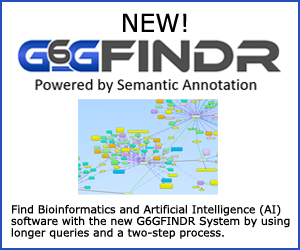BioNetGen
Category Cross-Omics>Pathway Analysis/Tools and Cross- Omics>Agent-Based Modeling/Simulation/Tools
Abstract BioNetGen™ is software product that can be used for the specification and simulation of 'rule-based models' of biochemical systems, including signal transduction, metabolic, and genetic regulatory networks.
It is a tool for automatically generating a 'biochemical reaction network' from user-specified rules for biomolecular interactions.
Rules are specified in the BioNetGen language (BNGL), which enables precise and extensible representation of biomolecular interactions on the level of protein domains.
BNGL files (specified by the extension .bngl) contain the data required to specify models (parameters, initial chemical species, rules of interactions, observables corresponding to features of the system) and also may contain commands that perform simulations on the model [simulation using Ordinary Differential Equations (ODEs) or stochastic simulation algorithm, simulation time, etc].
A user can explicitly indicate the parts of proteins involved in an interaction, the conditions upon which an interaction depends, the connectivity of proteins in a complex, and other aspects of protein- protein interactions (PPI).
The components of BioNetGen include the network generation engine 'BNG2', which is written in Perl, the simulation program 'Network', which is written in C, a plotting program called 'PhiBPlot', which is written in Java, and a graphical front-end called 'RuleBuilder', which is also written in Java.
The core component, BNG2, which has a command-line interface, processes BioNetGen input files to generate two (2) kinds of outputs: a 'chemical reaction network' derived by processing rules and/or the results of simulating a model.
Reaction networks are exported in a native .net format, in M-file format for processing by MATLAB, and in Systems Biology Markup Language (SBML).
A network encoded in SBML can be processed by a variety of SBML- compliant software tools.
An example of an SBML-compliant tool that complements BioNetGen is COPASI (see G6G Abstract Number 20296), which provides model analysis capabilities, such as parameter estimation methods, unavailable in the native BioNetGen environment.
Simulation results are exported as tabular data in plain-text files that have the extension .cdat or .gdat. A .cdat file contains time series for concentrations of chemical species.
A .gdat file contains time series for observables defined in a BioNetGen input file or .net file.
Simulations specified in an input file are preprocessed by BNG2 and then passed to Network, which is a simulation engine driver.
Network interfaces with the CVODE package, a set of routines for solving stiff and non-stiff initial value problems for systems of Ordinary Differential Equations (ODEs).
Network also provides an implementation of the direct method of Gillespie for stochastic simulations.
The command-line interface of Network allows a .net file to be processed directly without preprocessing by BNG2, but this option is unavailable for simulation in the on-the-fly mode, which necessarily requires communication between BNG2 and Network.
PhiBPlot is a utility for producing x-y plots from .cdat and .gdat files. The . cdat and .gdat files can also be processed by other plotting tools, such as Grace.
RuleBuilder provides a graphical user interface (GUI) to BioNetGen. It also provides a drawing tool for creating and editing models that may be particularly helpful to new users.
BioNetGen has been integrated into the Virtual Cell (VCell) (see G6G Abstract Number 20440) modeling environment as a stand-alone application called BioNetGen@VCell.
A BioNetGen service is callable from a VCell user interface and runs on a client computer.
The VCell user interface can be used to visualize and export simulation results. Alternatively, a 'VCell BioModel' can be automatically created from an SBML file generated by BioNetGen@VCell.
Working with BioNetGen@VCell application --
A BioNetGen@VCell service is a part of the Virtual Cell modeling and simulation framework.
It is a web-based tool that provides a mechanism for automatically generating a 'biochemical reaction network' from user-specified rules for biomolecular interactions.
It is callable from the ‘Virtual Cell’ and runs within the Virtual Cell on a client computer.
The first release of BioNetGen@VCell -
1) Implements the latest version of BioNetGen 2, in which connectivity of proteins in the complex can be explicitly specified.
2) Creates a Virtual Cell BioModel from the BioNetGen-generated reaction network.
3) Includes different simulation capabilities:
- a) Iterative network generation of the reaction network from a given set of seed species according to user-specified reaction rules;
- b) Time courses simulation using ODE-based deterministic simulation of a pre-generated network, SSA-based stochastic simulation of a pre-generated network, or on-the-fly network simulation and generation;
- c) Visualization of simulation results and different data export options.
4) Provides a capability to pre-equilibrate a network and to restart time courses simulation from any time point with modified parameter values.
5) Provides compatibility with other modeling and simulation tools (SBW etc. see G6G Abstract Number 20453) via export of the biochemical reaction network in SBML L2 format.
Detailed information about BNGL and how to write an input file for BioNetGen model is provided on the website (http://vcell.org/bionetgen).
Note: BioNetGen has been used to generate models for reaction networks with hundreds of thousands of species and reactions.
It is one of the few software tools available for generating physicochemical models of systems marked by combinatorial complexity - a hallmark of cellular signaling.
System Requirements
Contact manufacturer.
Manufacturer
The BioNetGen current development team includes researchers in
the Theoretical Division and Center for Nonlinear Studies at Los Alamos National Laboratory
,the Departments of Biology and Computer Science at the University of New Mexico,
the Department of Computational Biology at the University of Pittsburgh School of Medicine,
the Center for Cell Analysis and Modeling at the University of Connecticut Health Center, and
the Department of Biological Chemistry at the Johns Hopkins University School of Medicine.
Manufacturer Web Site BioNetGen
Price Contact manufacturer.
G6G Abstract Number 20466
G6G Manufacturer Number 104092







